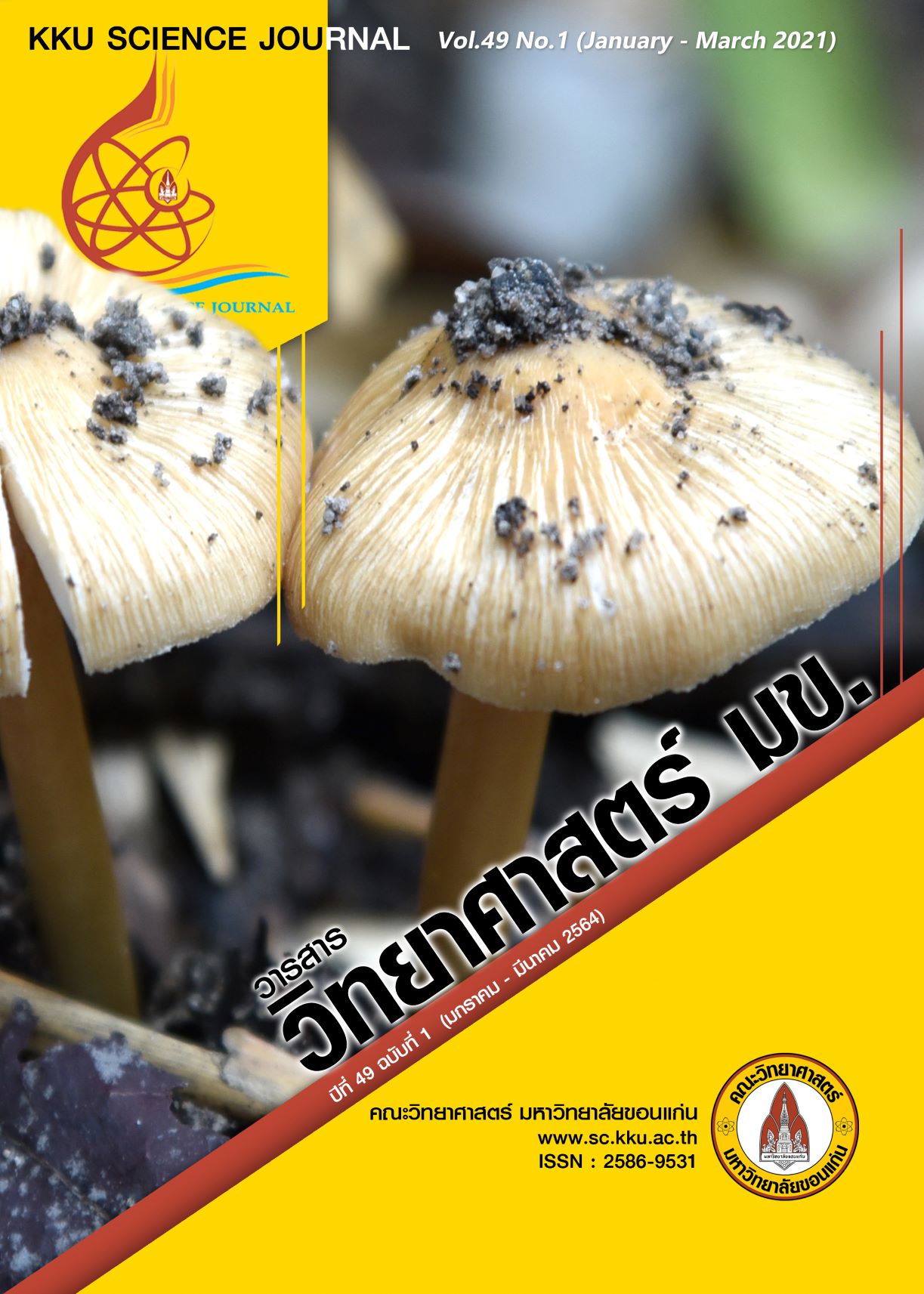Product Development of Rice Seasoning (Furikake) from Fish and Crispy Fried Seabass (Lates calcarifer) Skin
Main Article Content
Abstract
The utilization of small piece of crispy fried fish skin, waste from crispy fried fish skin process, was the objective of this study. Moreover, it was for highest benefit of utilization and new product development. This product was developed for consumers who want products that was convenient to consume. The study on suitable content of seasoned dried fish meat for protein supplement, suitable content of dried carrot for dietary fiber supplement, suitable content of crispy fried fish skin and quality of product were investigated. For result, it was showed that suitable basic formula for protein supplement composed of 28 % seasoned dried fish meat, 7% dried vegetable, 13% white sesame, 13% black sesame 7% soy sauce, 3% sugar, 2% salt, 6% dried seasoned seaweed, 15% water and 6 % seasoned powder (no MSG). The suitable content of dried carrot and crispy fried fish skin were 8% and 11%, respectively. Proximate compositions of this product were 3.19% moisture, 11.43% ash, 35.55% protein, 7.81% fat, 1.03% crude fiber and 41.76% total carbohydrate. The Energy and water activity were 380.59 kcal/100g and 0.242, respectively. Overall liking score of developed product was 8.63 which showed the acceptation of the product. Then rice seasoning (Furikake) from fish and crispy fried fish skin was alternative product for consumer who want to consume nutritional added food. Moreover, this product was a guide for manufacturers to produce more diverse products.
Article Details

This work is licensed under a Creative Commons Attribution-NonCommercial-NoDerivatives 4.0 International License.
References
กองโภชนาการ. (2544). ตารางแสดงคุณค่าทางโภชนาการของอาหารไทย. พิมพ์ครั้งที่ 1. กรุงเทพฯ: โรงพิมพ์องค์การทหารผ่านศึก. หน้า 7.
ดวงรัตน์ พรเทวบัญชา. (2554). การพัฒนาผงโรยข้าว (ฟูริคาเกะ) จากผักสลัด. วิทยานิพนธ์ปริญญาวิทยาศาสตรมหาบัณฑิต. สาขาวิชาเทคโนโลยีอาหาร มหาวิทยาลัยศิลปากร. นครปฐม. หน้า 31 - 63.
ชลอ ลิ้มสุวรรณ. (2536) . เนื้อเยื่อของปลาช่อน. คณะประมง มหาวิทยาลัยเกษตรศาสตร์, กรุงเทพฯ. 137 หน้า อ้างถึงในวรรณวิมล คล้ายประดิษฐ์. (2540). การผลิตเจลาตินจากหนักปลากะพงแดง. วิทยานิพนธ์วิทยาศาสตรมหาบัณฑิต สาขาวิชาผลิตภัณฑ์ประมง มหาวิทยาลัยเกษตรศาสตร์. กรุงเทพฯ. หน้า 10.
รจนา นุชนุ่ม. (2551). การพัฒนาผงโรยข้าว (ฟูริคาเกะ) จากปลาสลิด. วิทยานิพนธ์ปริญญาวิทยาศาสตรมหาบัณฑิต. สาขาวิชาเทคโนโลยีอาหาร มหาวิทยาลัยศิลปากร. นครปฐม. หน้า 48-99.
สํานักงานมาตรฐานผลิตภัณฑ์อุตสาหกรรม. (2547). มาตรฐานผลิตภัณฑ์ชุมชนผงปรุงรสอาหาร. (มผช.๔๙๔/๒๕๔๗) กองบริหารมาตรฐานผลิตภัณฑ์ชุมชน สํานักงานมาตรฐานผลิตภัณฑ์อุตสาหกรรม กระทรวงอุตสาหกรรม กรุงเทพฯ.
สํานักงานคณะกรรมการอาหารและยา. (2554). คู่มือรณรงค์การให้ความรู้เรื่องฉลากโภชนาการ. สํานักอาหาร สํานักงานคณะกรรมการอาหารและยา กระทรวงสาธารณสุข. หน้า 4-11.
อทิตา ชนะสิทธิ์. (2554). การพัฒนาผงโรยข้าวรสบูดูจากปลาสลิดจิตรลดารมควันร้อน. วิทยานิพนธ์ปริญญาวิทยาศาสตรมหาบัณฑิต. สาขาวิชาเทคโนโลยีทางอาหาร. จุฬาลงกรณ์มหาวิทยาลัย. กรุงเทพฯ. หน้า 59.
Aidos, I., Padt, A., Boom, R. M. and Luten, J. B. (2003). Quality of crude fish oil extracted from herring by- product of varying states of freshness. Journal of Food Science 68(2): 458 – 465.
AOAC. (1984). Official methods of analysis of AOAC International, 14th ed., Arlington: VA, USA: AOAC.
AOAC. (2000). Official methods of analysis of AOAC International, 17th ed., Gaithersburg, MD, USA: AOAC.
Archer, M. , Watson, R. and Denton, J. W. (2001) . Fish Waste Production in the United Kingdom: The Quantities Produced and Opportunities for Better Utilization. Sea fish Report Number SR537. Edinburgh: The Sea Fish Industry Authority. pp 1-55.
Daisho (Thailand). (2016). “ Furikake” What is it? [online]. Retrieved from: https://daishothai.com/th/knowledge/page/2/ (5 December, 2019)
Deming, D. M., Boileau, T. W.-M., Heintz, K. H., Atkinson, C. A. and Erdman, J. W. ( 2005). Carotenoids: linking chemistry, absorption, and metabolism to potential roles in human health and disease. pp. 201- 203. Cadenas, E. and Packer, L. (eds). In Handbook of antioxidants, revised and expanded. 2nd ed., New York: Marcel Dekker, Inc.
Lorenz, A. O., and Maynard, D. N. (1980). Knott’s Handbook for Vegetable Growers. 2nd ed., New York: John Wiley & Sons. pp 22-29.
Mana, Kumagai and Nihonfurkakekonwakai. (2001). Furikake-Nihon no shoku to shisou. Gakkuyoushobou Tokyo. 254 p. อ้างถึงในรจนานุชนุ่ม. (2551). การพัฒนาผงโรยข้าว (ฟูริคาเกะ) จากปลาสลิด. วิทยานิพนธ์ปริญญาวิทยาศาสตรมหาบัณฑิต. สาขาวิชาเทคโนโลยีอาหารมหาวิทยาลัยศิลปากร. นครปฐม. หน้า 18-19.
Speck, M. L. (1984). Compendium of Method for the Microbiological Examination of Food. American Public Health Association. Washington, DC.: Academic Press.
Wikipedia. (2019). Furikake. Retrieved from: https://en.wikipedia.org/wiki/Furikake (5 December, 2019).


